Urine diversion sanitation in Olympic Forest Park Beijing, China - Case study of sustainable sanitation projects
Germer, J., Xu, K. (2009)

Published in: 2009
Publisher:
Sustainable Sanitation Alliance (SuSanA)
Author:
Germer, J., Xu, K.
Uploaded by:
SuSanA secretariat
Partner profile:
common upload
10938 Views
175 Downloads
Location of library entry
Content - Summary
This case study is about a demonstration project for implementing UDDTs and nutrient cycling in a large public urban park - the Olympic Forest Park - in Beijing, China. The project is expected to serve 5.3 million visitor/year. The aim of the system is to interlink the sanitation material flows as a water and nutrient source with the green areas of the park as a water and nutrient sink. Reduced water and energy demand as well as the substitution of fertilizer by urine and faeces-derived manure are expected advantages.
DESE in cooperation with the Beijing Zhongyuan Engineering Design & Consulting Company (ZEDC) developed a decentralised treatment system, integrated urine separation and suggested reuse of the sanitation-derived nutrient resources in the park. The restrooms initially planned for the park were supposed to be equipped with conventional flush toilets and urinals. Wastewater disposal to the public sewer system was planned. Due to the size and topography of the park, this would have required a very complex and costly network of pipes and pump stations. In order to reduce the length of the network, decentralised treatment was considered. Membranes as well as granular biological reactors were chosen for on-site wastewater treatment.
Each of the flush toilet blocks has an individual tank system with an average volume of 75 m3 (50-100 m³). The brownwater undergoes a liquid/solid separation in the tanks and afterwards passes through a biological reactor. The reactor effluent flows through open drains towards the wetlands and water-bodies. It is anticipated that a large part of the effluent infiltrates and evaporates on the way. Scum and sludge that floats and settles in the septic tanks is removed via a vacuum truck.
A preliminary assessment shows that the urine tanks are currently about half full. This means that approx. 1000 m³ of yellow water (urine plus some flush water) has been collected in the period Sept. 2008 to April 2009. This is significantly less than the amount predicted from the model for an 8-month period (see Section 6 - 4,000 m³ yellow water was expected per year, or 2670 m³ for an 8-month period). Reasons for the lower collected amount could be that the park did not receive as many visitors as assumed in the calculations because of restrictive access, the delayed opening of one of the wings of the park and the harsh winter.
By recycling urine and faeces, € 12,650 per year (or 0.23 cent per visitor per year) worth of these fertilizers are substituted (based on currently subsidised fertilizer prices in China).
Bibliographic information
Germer, J., Xu, K. (2009). Urine diversion sanitation in Olympic Forest Park Beijing, China - Case study of sustainable sanitation projects. Sustainable Sanitation Alliance (SuSanA)
Filter tags
Case studies in SuSanA template East Asia & Pacific English Greywater or wastewater Urban (entire city) Urine Urine diversion dehydration toilets (UDDTs)














